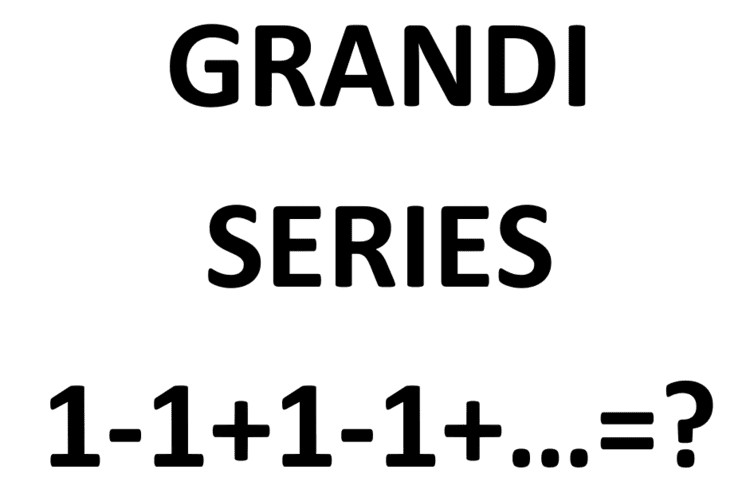Similar Infinite arithmetic series, Divergence of the sum of the reciprocals of the primes, Riemann zeta function | ||

In mathematics, the infinite series
Contents
is sometimes called Grandi's series, after Italian mathematician, philosopher, and priest Guido Grandi, who gave a memorable treatment of the series in 1703. It is a divergent series, meaning that it lacks a sum in the usual sense. On the other hand, its Cesàro sum is 1/2.
Unrigorous Methods
One obvious method to attack the series
1 − 1 + 1 − 1 + 1 − 1 + 1 − 1 + ...is to treat it like a telescoping series and perform the subtractions in place:
(1 − 1) + (1 − 1) + (1 − 1) + ... = 0 + 0 + 0 + ... = 0.On the other hand, a similar bracketing procedure leads to the apparently contradictory result
1 + (−1 + 1) + (−1 + 1) + (−1 + 1) + ... = 1 + 0 + 0 + 0 + ... = 1.Thus, by applying parentheses to Grandi's series in different ways, one can obtain either 0 or 1 as a "value". (Variations of this idea, called the Eilenberg–Mazur swindle, are sometimes used in knot theory and algebra.)
Treating Grandi's series as a divergent geometric series we may use the same algebraic methods that evaluate convergent geometric series to obtain a third value:
S = 1 − 1 + 1 − 1 + ..., so1 − S = 1 − (1 − 1 + 1 − 1 + ...) = 1 − 1 + 1 − 1 + ... = S1 - S = S1 = 2*S,resulting in S = 1/2. The same conclusion results from calculating −S, subtracting the result from S, and solving 2S = 1.
The above manipulations do not consider what the sum of a series actually means. Still, to the extent that it is important to be able to bracket series at will, and that it is more important to be able to perform arithmetic with them, one can arrive at two conclusions:
In fact, both of these statements can be made precise and formally proven, but only using well-defined mathematical concepts that arose in the 19th century. After the late 17th-century introduction of calculus in Europe, but before the advent of modern rigor, the tension between these answers fueled what has been characterized as an "endless" and "violent" dispute between mathematicians.
The formula for the sum to infinity of a Geometric series is
Divergence
In modern mathematics, the sum of an infinite series is defined to be the limit of the sequence of its partial sums, if it exists. The sequence of partial sums of Grandi's series is 1, 0, 1, 0, ..., which clearly does not approach any number (although it does have two accumulation points at 0 and 1). Therefore, Grandi's series is divergent.
It can be shown that it is not valid to perform many seemingly innocuous operations on a series, such as reordering individual terms, unless the series is absolutely convergent. Otherwise these operations can alter the result of summation. Further, the terms of Grandi's series can be rearranged to have its accumulation points at any interval of two or more consecutive integer numbers, not only 0 or 1. For instance, the series
(in which, after five initial +1 terms, the terms alternate in pairs of +1 and −1 terms) is a permutation of Grandi's series in which each value in the rearranged series corresponds to a value that is at most four positions away from it in the original series; its accumulation points are 3, 4, and 5.
